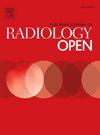MRI-based risk factors for intensive care unit admissions in acute neck infections
IF 2.9
Q3 RADIOLOGY, NUCLEAR MEDICINE & MEDICAL IMAGING
引用次数: 0
Abstract
Objectives
We assessed risk factors and developed a score to predict intensive care unit (ICU) admissions using MRI findings and clinical data in acute neck infections.
Methods
This retrospective study included patients with MRI-confirmed acute neck infection. Abscess diameters were measured on post-gadolinium T1-weighted Dixon MRI, and specific edema patterns, retropharyngeal (RPE) and mediastinal edema, were assessed on fat-suppressed T2-weighted Dixon MRI. A multivariate logistic regression model identified ICU admission predictors, with risk scores derived from regression coefficients. Model performance was evaluated using the area under the curve (AUC) from receiver operating characteristic analysis. Machine learning models (random forest, XGBoost, support vector machine, neural networks) were tested.
Results
The sample included 535 patients, of whom 373 (70 %) had an abscess, and 62 (12 %) required ICU treatment. Significant predictors for ICU admission were RPE, maximal abscess diameter (≥40 mm), and C-reactive protein (CRP) (≥172 mg/L). The risk score (0−7) (AUC=0.82, 95 % confidence interval [CI] 0.77–0.88) outperformed CRP (AUC=0.73, 95 % CI 0.66–0.80, p = 0.001), maximal abscess diameter (AUC=0.72, 95 % CI 0.64–0.80, p < 0.001), and RPE (AUC=0.71, 95 % CI 0.65–0.77, p < 0.001). The risk score at a cut-off > 3 yielded the following metrics: sensitivity 66 %, specificity 82 %, positive predictive value 33 %, negative predictive value 95 %, accuracy 80 %, and odds ratio 9.0. Discriminative performance was robust in internal (AUC=0.83) and hold-out (AUC=0.81) validations. ML models were not better than regression models.
Conclusions
A risk model incorporating RPE, abscess size, and CRP showed moderate accuracy and high negative predictive value for ICU admissions, supporting MRI’s role in acute neck infections.
急性颈部感染重症监护病房入院的核磁共振危险因素
目的:我们评估了危险因素,并根据急性颈部感染的MRI结果和临床数据制定了预测重症监护病房(ICU)入院的评分。方法回顾性研究mri确诊的急性颈部感染患者。在钆后t1加权Dixon MRI上测量脓肿直径,在脂肪抑制的t2加权Dixon MRI上评估特定水肿模式,咽后(RPE)和纵隔水肿。多变量逻辑回归模型确定了ICU入院的预测因素,并根据回归系数得出风险评分。利用接收机工作特性分析的曲线下面积(AUC)来评估模型性能。机器学习模型(随机森林,XGBoost,支持向量机,神经网络)进行了测试。结果共纳入535例患者,其中373例(70 %)存在脓肿,62例(12 %)需要ICU治疗。RPE、最大脓肿直径(≥40 mm)和c反应蛋白(CRP)(≥172 mg/L)是ICU入院的重要预测因素。风险评分(0−7)(AUC = 0.82, 95 %可信区间(CI) 0.77 - -0.88)优于CRP (AUC = 0.73, 95 %可信区间0.66 - -0.80,p = 0.001),最大直径脓肿(AUC = 0.72, 95 %可信区间0.64 - -0.80,p & lt; 0.001),和RPE (AUC = 0.71, 95 %可信区间0.65 - -0.77,p & lt; 0.001)。截止值>; 3的风险评分产生以下指标:敏感性66 %,特异性82 %,阳性预测值33 %,阴性预测值95 %,准确性80 %,优势比9.0。在内部验证(AUC=0.83)和保留验证(AUC=0.81)中,判别性能是稳健的。ML模型并不优于回归模型。结论结合RPE、脓肿大小和CRP的风险模型对ICU入院患者具有中等准确性和较高的阴性预测值,支持MRI在急性颈部感染中的作用。
本文章由计算机程序翻译,如有差异,请以英文原文为准。
求助全文
约1分钟内获得全文
求助全文
来源期刊

European Journal of Radiology Open
Medicine-Radiology, Nuclear Medicine and Imaging
CiteScore
4.10
自引率
5.00%
发文量
55
审稿时长
51 days
 求助内容:
求助内容: 应助结果提醒方式:
应助结果提醒方式:


